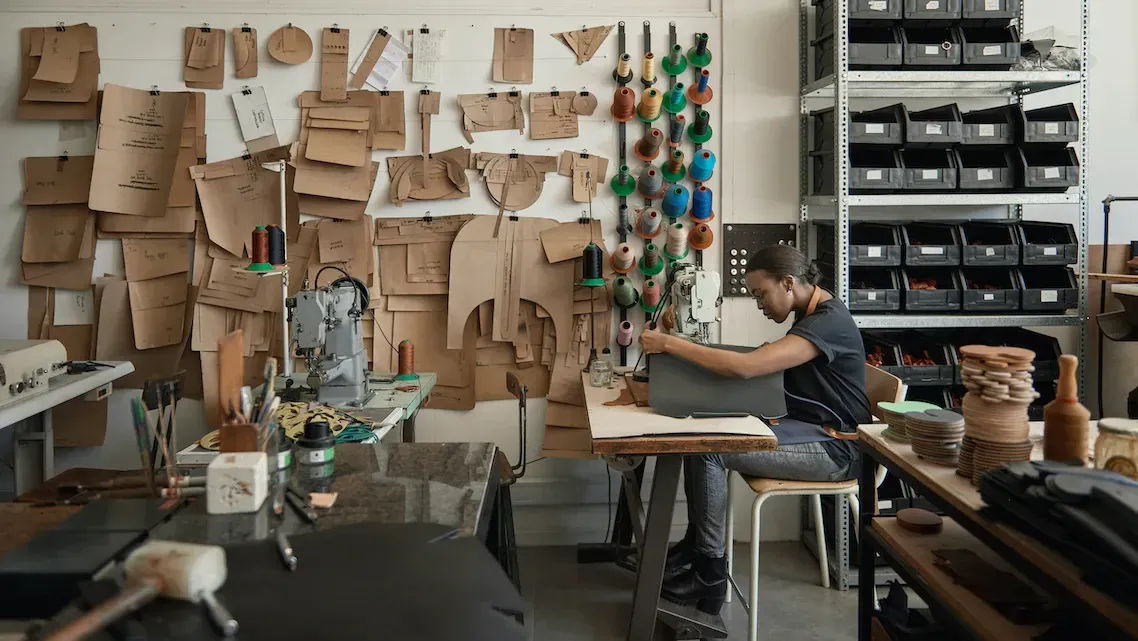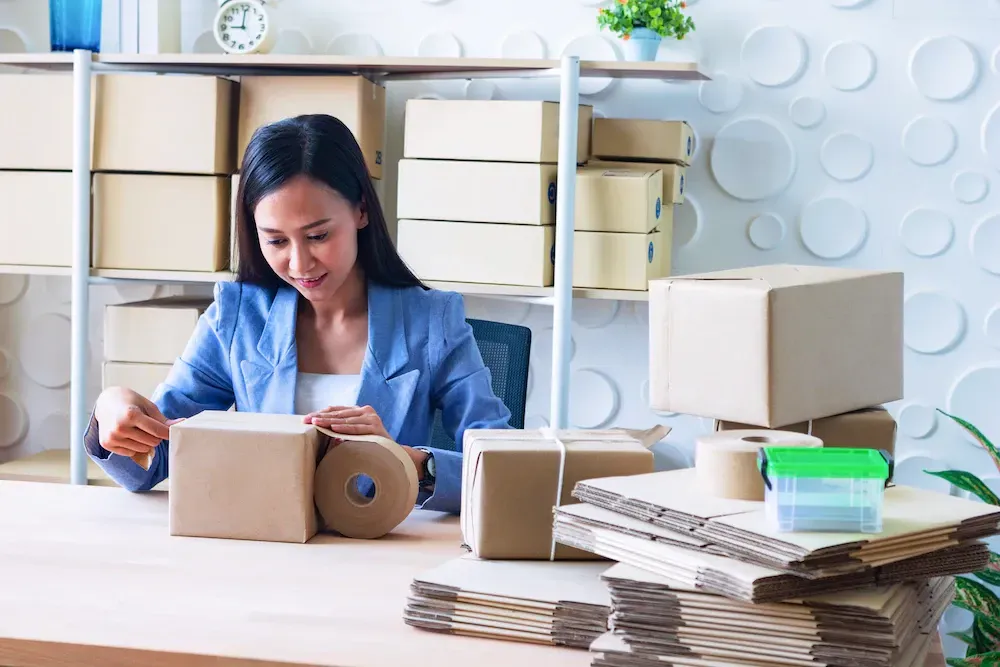What I Learned About Starting A New Creative Business

Most people who work in the arts can say they moonlight in some other profession to either top up the coffers or fulfil their creative urge.
I am no different, starting up a studio-based business during the pandemic while maintaining my arts journalism career.
Making the decision to begin a new venture is largely never rational and often passion driven, but trusting yourself and your skill set is key to getting it right.
While some creatives choose to keep those aspects of their professional life siloed, there are also benefits to the bleed of skills across career pathways.
Here are some of the lessons – and the secrets – to harness when starting a new creative business, and how to turn those old learnings of portfolio careers into new gains.
1. Know why.
Don’t do it unless you can rattle the elevator pitch without hesitation. It needs to be ingrained in why you are taking on this venture.
2. You don’t need a fancy business plan.
But you do need to formalise your key vision, and goals (first year; second year; five years) in a simple document.
A new business moves quickly and can organically grow as it gets its footing. It can be overwhelming at first. Don’t get caught up with doing things blindly. You need to stay strategic and on track, or adjust.
3. Don’t rush to launch or open.
Starting a new business is about so much more than having a business number, a logo and the keys to a space.
You need to have everything sorted, from invoicing templates to knowing how you will pack and ship your products, to doing a resources edit on everything you sell – yep, you need to know how long it takes to make, what it costs, and how quickly you can reorder supplies.
4. Know your limits.
If you hate doing your taxes every year, then you need to account for someone to manage the financial side of your business – a casual bookkeeper – before you open the doors, because you are having yourself on if you think you can wing it.
5. Get your product line sorted.
This is not about a nice range of nice things you like making. You have to be confident you can consistently deliver the same product at volume in a timely manner.
6. Branding is everything.
The easy ones we know are: company name, logo, colour, aesthetic… but it is so much more.
Today you are expected to use consistent language, messaging, storytelling – and you are expected to be genuine.
7. Know your brand ethics.
Brand ethics are increasingly important today to public perception. Take a look at your suppliers and how they make things.
Do you embrace sustainable practices or use carbon offsets? Do you acknowledge Country on which the business runs? This is all part of holistic brand messaging today.
8. Define your hours.
Just because you are a studio-based business doesn’t mean you don’t have regular work hours – define them and stick to them.
9. Protect your making time.
Clients will expect to be able to visit you when they want. Again, define your hours and stick to them.
Starting out, I would enthusiastically welcome anyone, at any hour, because they loved what we were doing … ahem, no retail based business does that, so why should you? Define your opening hours or open studio schedule so it becomes known.
10. Admin will take up about a third of your time.
Correspondence, finding stockists and business leads, shipping, marketing and social media, tracking inventory (on top of invoicing and accounts) – they can screw you up if you don’t get a grip on it.
Set half a day aside each week, or an hour every morning, and lock that time in. Put an alarm on your phone to get you in the habit.
11. Treat your studio practice like a job, not just your business.
Be constant and consistent in making your work. But also be persistent in staying creative and finding new ways to make.
You have to constantly stay on top of your stock levels and offerings. Nothing will damage your business more than not being able to deliver on orders, or by coming across as stale.
12. Get in the habit of a weekly studio clean.
If you are a studio-based business, you need to be presentable to clients at quick notice.
13. Go to design fairs, makers markets, art fairs.
When you are a small studio-business, you need to know your market – your competition and your point of difference. It is also a great way for solving those display or packaging problems you can’t get your head around, by seeing how others do things.
14. Open studios are a great way to sell.
Every time we open our doors, we are always surprised by the volume of casual sales that quickly add up by the end of the day.
So why not plan them regularly – seasonally, monthly – or play off local events nearby such as market days or mini festivals.
15. You can’t always pick a buyer.
Big lesson learned when working in a San Francisco gallery during the dot-com boom of the late 1990s – pockets can be very deep in board shorts as well as designer clothing.
16. The majority of visitors to your studio business open day are first time visitors.
Open studios are great for growing your support network. And surprisingly, a lot of first time visitors will buy – but you need to give them a show.
Plan a demo or display, but mostly, just be prepared to give them your time and bring them on your journey.
17. You cannot operate a studio-based business without an online shop.
If the pandemic taught us anything, it was that today people embrace the online purchase, so maximise your profits and brand management and do it through your website.
18. Diversification of your business and your studio is key.
Once you get rolling, remember to keep your website and social channels fresh. Continue to think ahead on sales or themes around your product to capture new interest.
Keep working on new product development on the side – plan time to just play and prototype.
19. Remember to constantly check back in on your business plan and goals.
When that first anniversary rolls around and you are totally exhausted, the question will arise: ‘Why the hell did I start this?’
Create a six-monthly calendar coffee date for a business wellbeing catch-up with yourself. Reassess not only how and where the studio business is growing, but also your mental and physical state.
Ask how sustainable the demands are, and what you need to adjust.

Image: Shutterstock.
20. Test first, test early when it comes to packaging and shipping.
It’s great to have sexy, desirable stock but unless you work out how you will present your offerings to the client - either in-person or shipped - this will hold you back.
Over the first months, we lost stock with breakages in shipping. We also found supply levels inconsistent to maintain our recycling packaging ethos. And knowing how much, and when, to invest in branded packaging can be confusing.
The answer to all these teething problems is test first, test early.
21. You need stockists to grow.
Your online shop and in-studio are great selling channels, but they are not enough to grow a sustainable studio business.
Just like an artist has a gallery to represent them, makers rely on stockists to extend their product placement. Do your research and find the right match.
Know how you will operate – on consignment or wholesale – before you approach them. Know your payment terms, again before you approach them. Know what your views are on product exclusivity, and be sure to find the right balance between geographic spread versus freight costs.
22. You need supplies to make. You need packaging to present.
One of the hardest things when starting out is understanding your supply levels – too little; too much.
There is also a financial load on these. You order too much and you have to carry that load before you offload stock.
We recommend mapping it out. Project your use, and know your needs for each item you sell. Maintain a base stock level in your inventory to fill orders, and know your basic supply levels to maintain that base.
24. Getting the timing and offer right with workshops.
Workshops are also a good way to expand your offerings and create a new income stream and client base, but only do it when your business has the maturity to take them on.
They take a lot of work; you need to be on top of your insurance and H&S – but they can be very profitable.
25. Display is an extension of your products, not just your brand.
If you are opening your studio or doing fairs (and even thinking of your stockists), display is key to present your wares. We would recommend being consistent with your brand.
26. Reach out.
Opening our studio business, we have been surprised by the level of community uptake and support. Look at your local tourism, council and information networks to communicate what you are doing.
Reach out, and it will come back to you threefold.
27. If it stops being fun, then stop.
This article was originally published by our friends at ArtsHub Australia.
Written by Gina Fairley, ArtsHub's National Visual Arts Editor.
